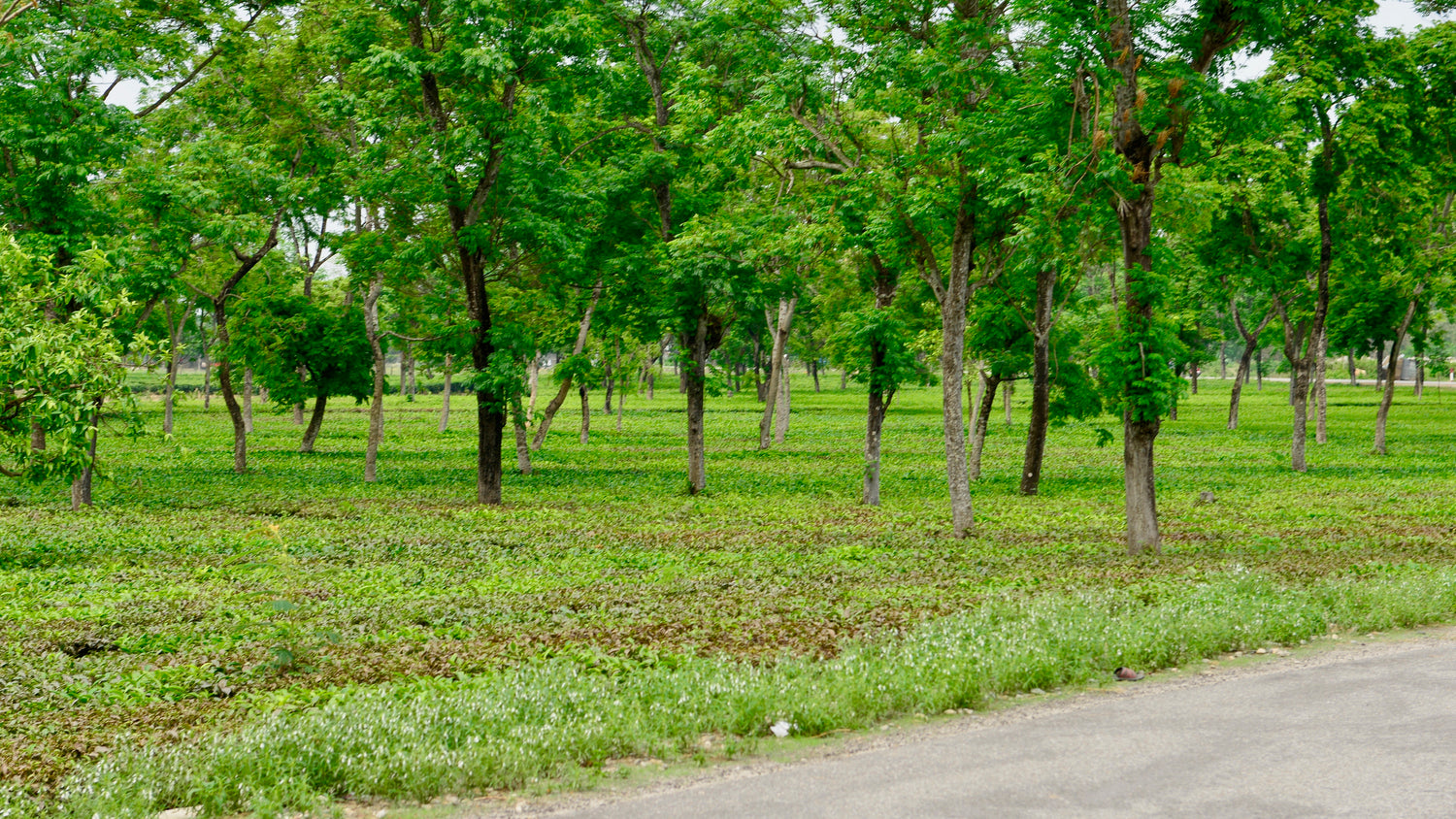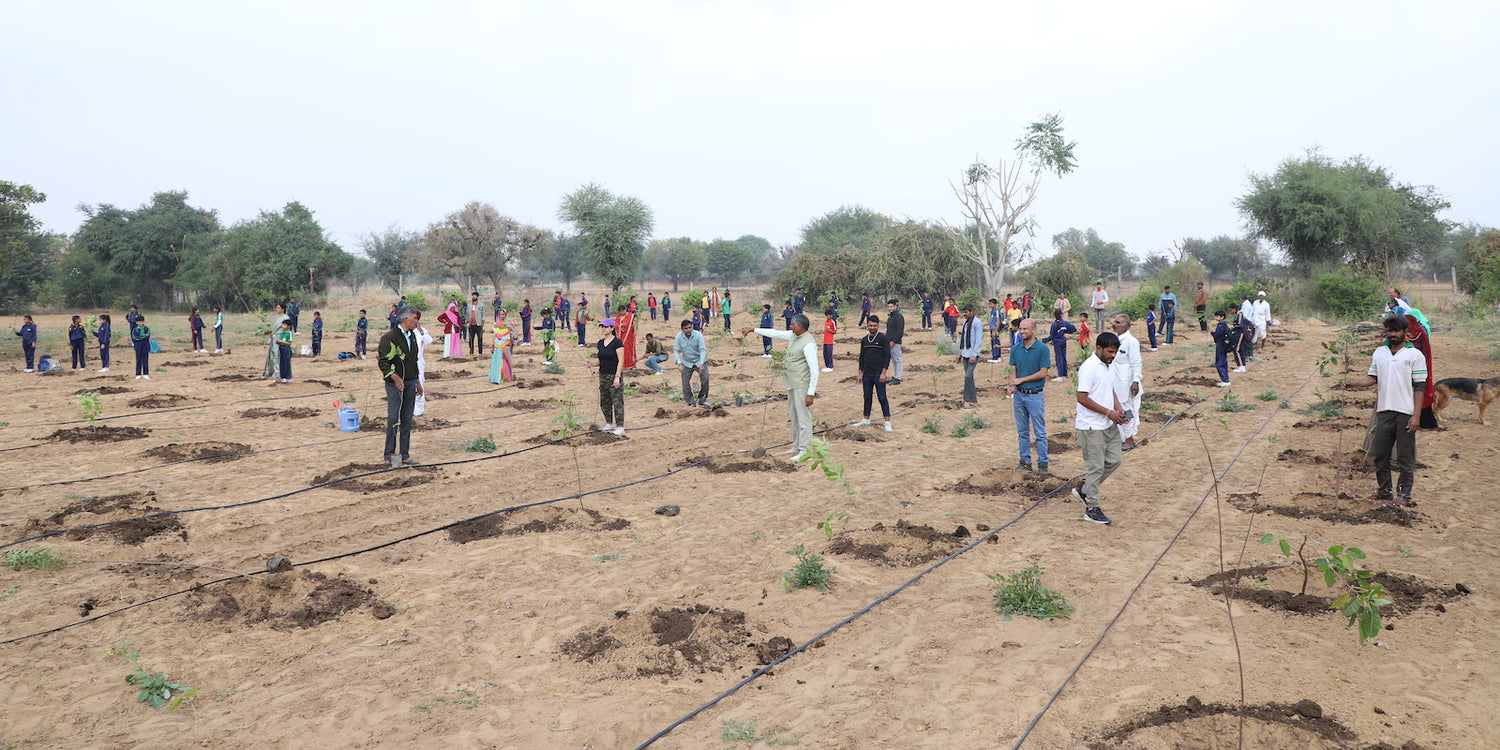Agroforestry in Telangana: Sustainable Farming in the Heart of Deccan
Telangana, located in the heart of the Deccan Plateau, is an agricultural hub known for its semi-arid landscapes, dry climates, and diverse ecosystems Read more
Connect with us
-
👥 Corporates
If you are looking for:
- 🌲 Tree Plantation Events
- 📊 CSR Projects
📧 corporate@growbilliontrees.com
📞 +91 9699723523
💬 +91 9325931304 WhatsApp (Only)
🕒 Mon - Sat | 10am - 7pm IST
-
🧩 Tree Plantation NGOs
If you are looking for:
- 💰 Financial Assistance
- 🤝 Operational Support
📧 support@growbilliontrees.com
📞 +91 9699723523
💬 +91 9325931304 WhatsApp (Only)
🕒 Mon - Sat | 10am - 7pm IST
-
🌼 Individuals
If you are looking for:
- 👥 Group Tree Plantation Drive
- 🌳 Bulk Tree Plantation
📞 +91 9699723523
💬 +91 9325931304 WhatsApp (Only)
🕒 Mon - Sat | 10am - 7pm IST
Trending
Trees for Corporates
Agroforestry in Telangana: Sustainable Farming in the Heart of Deccan
Telangana, located in the heart of the Deccan Plateau, is an agricultural hub known for its semi-arid landscapes, dry climates, and diverse ecosystems.
Despite its agricultural importance, the state faces challenges such as land degradation, water scarcity, and climate variability.
In this scenario, agroforestry – the strategic integration of trees, crops, and livestock – emerges as a game-changing solution, offering sustainability, economic growth, and environmental restoration.
This article explores the historical context, scientific benefits, environmental impacts, and prospects of agroforestry in Telangana.
We also highlight how Grow Billion Trees actively promotes and executes agroforestry projects to empower farmers and restore ecosystems.
Historical Context of Agroforestry in Telangana
Telangana’s roots in agroforestry date back centuries when rural communities planted trees like Neem (Azadirachta indica), Tamarind (Tamarindus indica), and Banyan (Ficus benghalensis) around farms and villages.
These trees provided shade, fodder, fruits, and timber, supporting livelihoods in semi-arid regions.
Tribal communities in Adilabad and Khammam traditionally practiced agroforestry by growing fruit trees and medicinal plants alongside food crops. Over time, commercial agriculture led to monocropping, depleting soil health and groundwater levels.
With rising awareness of climate challenges, Telangana is rediscovering agroforestry’s importance as a sustainable farming solution to ensure food security, ecological balance, and farmer resilience.
The Need for Agroforestry in Telangana
1. Addressing Land Degradation
Telangana’s soils are prone to erosion and nutrient depletion due to over-cultivation. Agroforestry restores soil fertility by introducing organic matter and reducing erosion.
2. Water Resource Management
The state’s semi-arid zones and irregular rainfall patterns pose water management challenges. Agroforestry enhances groundwater recharge and reduces evaporation, optimizing water use.
3. Combating Climate Variability
Frequent droughts and temperature extremes impact crop yields in Telangana. Agroforestry systems create microclimates that protect crops and livestock from harsh weather.
4. Enhancing Livelihoods
Small and marginal farmers in Telangana benefit from diversified incomes through timber, fruits, and non-timber forest products like resin, honey, and fodder.
5. Promoting Biodiversity
Agroforestry fosters biodiversity by creating habitats for pollinators, birds, and native species across farmlands.
Scientific Benefits of Agroforestry in Telangana
- Soil Fertility Enhancement: Trees like Subabul and Gliricidia fix nitrogen in the soil, improving fertility and crop yields by 20–30%.
- Water Conservation: Tree root systems reduce water runoff and enhance groundwater recharge, benefiting drought-prone districts like Mahbubnagar.
- Carbon Sequestration: Agroforestry systems sequester up to 30 tons of carbon dioxide per hectare annually, making Telangana’s farmlands climate-friendly.
Agroforestry Models in Telangana
1. Silvo-Pastoral Systems
This system integrates fodder trees and grasses to provide livestock feed while improving degraded lands. Popular in Nizamabad and Karimnagar, silvo-pastoral agroforestry boosts dairy farming.
2. Horti-Agroforestry
Fruit-bearing trees like Mango, Guava, and Pomegranate are intercropped with pulses or grains, creating profitable, sustainable farming systems.
3. Agri-Silviculture
Crops like cotton, pulses, and groundnuts are grown alongside timber species such as Eucalyptus and Teak, providing both short-term and long-term economic benefits.
4. Boundary Plantations
Trees like Neem, Subabul, and Bamboo are planted along farm boundaries to protect crops, reduce wind erosion, and generate income through timber.
5. Mangrove Agroforestry
In coastal regions of Telangana’s Godavari basin, mangroves are intercropped with rice fields to enhance flood resilience and improve saline soils.
Fun Facts About Agroforestry in Telangana
- Mango Belt: Telangana’s agroforestry systems include Mango plantations, contributing to India’s global mango exports.
- Subabul Magic: Subabul trees, commonly grown in Telangana, enrich the soil and provide high-quality fodder for livestock.
- Eucalyptus Boom: Telangana’s Eucalyptus-based agroforestry supports local industries like paper, plywood, and construction.
Environmental Impact of Agroforestry in Telangana
1. Soil Conservation
Agroforestry systems reduce soil erosion in hilly and semi-arid regions, improving overall soil structure and fertility.
2. Water Security
Tree-based systems improve water infiltration, recharge groundwater, and reduce evaporation, especially in drought-prone districts like Rangareddy.
3. Carbon Sequestration
Trees in agroforestry systems absorb carbon dioxide, helping Telangana contribute to India’s climate action goals.
4. Biodiversity Enhancement
Agroforestry transforms farmlands into rich ecosystems that support pollinators, birds, and small wildlife, boosting ecological stability.
Challenges in Adopting Agroforestry in Telangana
- Lack of Awareness: Many farmers lack knowledge about agroforestry’s economic and ecological benefits.
- Policy Barriers: Regulations around tree felling and timber trade can discourage farmers from planting timber species.
- Water Availability: Sustaining agroforestry systems in Telangana’s drylands requires innovative water management techniques.
- Market Access: Farmers often face challenges selling timber, fruits, and other agroforestry products at fair prices.
Grow Billion Trees: Driving Agroforestry in Telangana
Grow Billion Trees is a key player in promoting agroforestry across Telangana, focusing on ecosystem restoration, farmer empowerment, and climate resilience.
Collaborations
- Partnering with local NGOs, self-help groups, and agricultural universities to develop sustainable agroforestry models.
- Working closely with Telangana’s Forest Department to restore degraded lands and improve tree cover.
Execution Strategies
- Tree Nurseries: Establishing nurseries to supply high-quality saplings of species like Neem, Mango, Eucalyptus, and Teak.
- Farmer Training: Conducting workshops and demonstrations to educate farmers about agroforestry techniques, benefits, and maintenance.
- Water Solutions: Promoting drip irrigation and rainwater harvesting to sustain agroforestry systems in semi-arid regions.
- Market Support: Connecting farmers with markets for timber, fruits, and fodder to ensure profitable returns.
Key Achievements by Grow Billion Trees
- Tree Plantations: Over 4 million trees planted across Telangana, increasing green cover and improving soil health.
- Farmer Empowerment: Trained over 8,000 farmers in agroforestry practices, boosting their incomes by up to 35%.
- Ecosystem Restoration: Rejuvenated over 50,000 hectares of degraded land through innovative agroforestry systems.
- Water Management: Implemented sustainable water solutions, benefiting farmers in drought-affected districts.
Future Prospects for Agroforestry in Telangana
By 2030, agroforestry in Telangana can:
- Increase the state’s tree cover by 20%, aligning with India’s national reforestation targets.
- Restore over 1 million hectares of degraded land, enhancing agricultural productivity.
- Support 30,000+ farming households with sustainable incomes through tree-based farming systems.
- Improve water resilience and biodiversity in Telangana’s semi-arid regions.
Conclusion
Agroforestry in Telangana stands as a beacon of hope for sustainable agriculture and environmental restoration.
By blending trees with crops and livestock, agroforestry addresses the state’s key challenges, such as soil erosion, water scarcity, and climate variability, while boosting farmer incomes.
Grow Billion Trees plays a vital role in promoting and executing agroforestry projects across Telangana, empowering farmers with training, saplings, and market access.
Through collective efforts, agroforestry can transform Telangana’s agricultural landscapes into resilient, productive, and sustainable ecosystems.
The future of Telangana lies in embracing agroforestry as a pathway to growth, sustainability, and prosperity. Together, we can nurture the heart of the Deccan Plateau into a greener, thriving agricultural hub.
Mango Agroforestry in Telangana
Telangana's love for mangoes makes it a natural fit for agroforestry. Mango trees provide sweet profits while stabilizing soil, shading crops, and thriving in Telangana’s semi-arid climate.
Eucalyptus Agroforestry in Telangana
Fast-growing and versatile, Eucalyptus trees offer timber for paper and construction industries. They pair well with crops like pulses and cotton in Telangana’s agroforestry systems.
Subabul in Telangana Agroforestry
Subabul trees are nitrogen-fixing powerhouses. They enrich soil, provide livestock fodder, and grow fast, making them perfect for Telangana’s drought-prone landscapes.
Silvo-Pastoral Systems in Telangana
Combining fodder trees with grasses ensures livestock thrive while protecting Telangana’s degraded lands, turning barren fields into productive ecosystems.
Neem Agroforestry in Telangana
Neem trees boost soil health, repel pests, and provide medicinal benefits, making them essential for Telangana farmers seeking sustainability and profitability.
Agri-Silviculture in Telangana
This system integrates crops like cotton and groundnuts with timber trees, ensuring farmers get short-term gains and long-term timber profits.
Horti-Silviculture Systems in Telangana
Fruit trees like guava, pomegranate, and tamarind are intercropped with timber species, creating food security and a double-income strategy for Telangana’s farmers.
Bamboo Agroforestry in Telangana
Bamboo grows fast, provides timber and fodder, and supports local industries. It’s eco-friendly, profitable, and perfect for Telangana’s semi-arid zones.
Agroforestry for Soil Health in Telangana
Trees improve soil organic matter, fix nutrients, and prevent erosion, ensuring Telangana’s farmlands remain fertile and productive for generations.
Water Conservation through Agroforestry in Telangana
Tree roots recharge groundwater and reduce evaporation, helping Telangana combat its water woes while supporting sustainable agriculture.
Agroforestry for Climate Resilience in Telangana
Agroforestry creates microclimates that protect crops from Telangana’s heatwaves, droughts, and erratic weather, ensuring stable farm outputs.
Grow Billion Trees Agroforestry in Telangana
By offering saplings, training, and market support, Grow Billion Trees helps Telangana farmers adopt agroforestry, increasing productivity while restoring degraded lands.
You may like
Corporate Plantations
FAQ
What is agroforestry in Telangana?
Agroforestry combines trees, crops, and livestock to boost productivity and restore ecosystems. Grow Billion Trees promotes this sustainable practice to support Telangana’s farmers and landscapes.
Why is agroforestry important in Telangana?
It combats soil erosion, improves water conservation, and ensures diversified incomes. Grow Billion Trees helps farmers adopt agroforestry to tackle Telangana’s climate and agricultural challenges.
How does agroforestry help drought-prone areas in Telangana?
Trees improve groundwater recharge, reduce water evaporation, and enhance soil moisture. Grow Billion Trees promotes drought-resilient systems to benefit Telangana’s semi-arid regions.
Which trees are popular for agroforestry in Telangana?
Mango, Subabul, Eucalyptus, and Neem are widely used for their soil-enriching, timber, and income-generating benefits. Grow Billion Trees provides these saplings for farmer adoption.
How does agroforestry improve soil health in Telangana?
Trees fix nitrogen, prevent erosion, and add organic matter, rejuvenating Telangana’s overworked soils. Grow Billion Trees supports farmers in restoring soil productivity sustainably.
Can agroforestry improve water availability in Telangana?
Yes, tree roots recharge groundwater and reduce runoff, ensuring water sustainability in Telangana’s drylands. Grow Billion Trees encourages water-smart agroforestry systems.
How does silvo-pastoral agroforestry benefit Telangana farmers?
This system integrates fodder trees and grasses, ensuring livestock feed and soil restoration. Grow Billion Trees promotes silvo-pastoral systems for Telangana’s livestock farmers.
What role does mango play in Telangana’s agroforestry?
Mango trees thrive in Telangana’s climate, providing shade, sweet returns, and improved soil health. Grow Billion Trees encourages mango-based agroforestry for steady farmer incomes.
How does agroforestry address climate change in Telangana?
Agroforestry sequesters carbon, creates microclimates, and protects crops from extreme heat and drought. Grow Billion Trees implements systems to build Telangana’s climate resilience.
What challenges do Telangana farmers face with agroforestry?
Farmers often face water scarcity, policy hurdles, and market access issues. Grow Billion Trees bridges these gaps through resources, training, and sustainable practices.
How does Grow Billion Trees support agroforestry in Telangana?
We provide saplings, farmer training, and market access, empowering farmers to adopt agroforestry and restore Telangana’s degraded lands for a greener future.
Is agroforestry profitable for small farmers in Telangana?
Absolutely! Agroforestry offers short-term crops, long-term timber, and fruits, ensuring diversified and sustainable incomes. Grow Billion Trees makes it accessible for all farmers.























